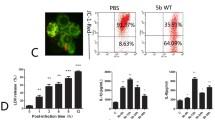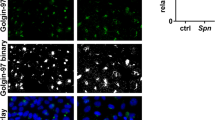Abstract
Mycobacterium avium: subsp. hominissuis (MAH) is an opportunistic pathogen that commonly infects immunocompromised individuals. Recently, we described an invasive phenotypic change MAH undergoes when incubated with lung airway epithelial host cells for 24 h, which is accompanied with microaggregate formation in vitro. The microaggregate phenotype also resulted in higher colonization in the lungs of mice early during infection. Previously, we identified genes highly regulated during microaggregate formation and further characterized the function of two highly upregulated bacterial proteins, mycobacterial binding protein-1 (MBP-1) and mycobacterial inversion protein-1 (MIP-1), which were found to be involved in binding and invasion of the respiratory mucosa. While these studies are valuable in understanding the pathogenesis of MAH, they primarily investigated the bacteria during microaggregate infection without commenting on the differences in the host response to microaggregate and planktonic infection. The bacteria–host interaction between microaggregates and epithelial cells was examined in a variety of assays. Using a transwell polarized epithelial cell model, microaggregates translocated through the monolayer more efficiently than planktonic bacteria at set timepoints. In addition, during infection with microaggregate and planktonic bacteria, host phosphorylated proteins were identified revealing differences in immune response, glutathione synthesis, and apoptosis. The host immune response was further investigated by measuring pro-inflammatory cytokine secretion during microaggregate and planktonic infection of BEAS-2B bronchial epithelial cells. The epithelial cells secreted more CCL5 during infection with microaggregates suggesting that this chemokine may play an important role during microaggregate invasion. Subsequent experiments showed that microaggregates are formed more efficiently in the presence of CCL5, suggesting that MAH had evolved a strategy to use the host response in its benefit. Collectively, this study establishes the different nature of infection by planktonic bacteria and microaggregates.





Similar content being viewed by others
References
Alkhuder K et al (2009) Glutathione provides a source of cysteine essential for intracellular multiplication of Francisella tularensis. PLoS Pathog 5(1):e1000284
Babrak L et al (2015) The environment of “Mycobacterium avium subsp. hominissuis” microaggregates induces synthesis of small proteins associated with efficient infection of respiratory epithelial cells. Infect Immun 83(2):625–636
Bai X et al (2011) IL-32 expression in the airway epithelial cells of patients with Mycobacterium avium complex lung disease. Int Immunol 23(11):679–691
Bermudez LE, Young LS (1994) Factors affecting invasion of HT-29 and HEp-2 epithelial cells by organisms of the Mycobacterium avium complex. Infect Immun 62(5):2021–2026
Bermudez LE et al (2002) The efficiency of the translocation of Mycobacterium tuberculosis across a bilayer of epithelial and endothelial cells as a model of the alveolar wall is a consequence of transport within mononuclear phagocytes and invasion of alveolar epithelial cells. Infect Immun 70(1):140–146
Bermudez LE, Petrofsky M, Sangari F (2004) Intracellular phenotype of Mycobacterium avium enters macrophages primarily by a macropinocytosis-like mechanism and survives in a compartment that differs from that with extracellular phenotype. Cell Biol Int 28(5):411–419
Bras AM, Ketley JM (1999) Transcellular translocation of Campylobacter jejuni across human polarised epithelial monolayers. FEMS Microbiol Lett 179(2):209–215
Burns JL et al (2001) Transcytosis of gastrointestinal epithelial cells by Escherichia coli K1. Pediatr Res 49(1):30–37
Buza JJ et al (2003) Mycobacterium avium subsp. paratuberculosis infection causes suppression of RANTES, monocyte chemoattractant protein 1, and tumor necrosis factor alpha expression in peripheral blood of experimentally infected cattle. Infect Immun 71(12):7223–7227
Cambier CJ, Falkow S, Ramakrishnan L (2014) Host evasion and exploitation schemes of Mycobacterium tuberculosis. Cell 159(7):1497–1509
Caudy AA et al (2003) A micrococcal nuclease homologue in RNAi effector complexes. Nature 425(6956):411–414
Champsi J, Young LS, Bermudez LE (1995) Production of TNF-alpha, IL-6 and TGF-beta, and expression of receptors for TNF-alpha and IL-6, during murine Mycobacterium avium infection. Immunology 84(4):549–554
Chan J et al (1991) Lipoarabinomannan, a possible virulence factor involved in persistence of Mycobacterium tuberculosis within macrophages. Infect Immun 59(5):1755–1761
Chan J et al (1992) Killing of virulent Mycobacterium tuberculosis by reactive nitrogen intermediates produced by activated murine macrophages. J Exp Med 175(4):1111–1122
Cooper AM et al (1993) Disseminated tuberculosis in interferon gamma gene-disrupted mice. J Exp Med 178(6):2243–2247
Covert TC et al (1999) Occurrence of nontuberculous mycobacteria in environmental samples. Appl Environ Microbiol 65(6):2492–2496
Danelishvili L et al (2003) Mycobacterium tuberculosis infection causes different levels of apoptosis and necrosis in human macrophages and alveolar epithelial cells. Cell Microbiol 5(9):649–660
Devergne O et al (1994) Production of the RANTES chemokine in delayed-type hypersensitivity reactions: involvement of macrophages and endothelial cells. J Exp Med 179(5):1689–1694
Duell BL et al (2013) Human bladder uroepithelial cells synergize with monocytes to promote IL-10 synthesis and other cytokine responses to uropathogenic Escherichia coli. PLOS ONE 8(10):e78013
Ehlers S (2009) Lazy, dynamic or minimally recrudescent? On the elusive nature and location of the mycobacterium responsible for latent tuberculosis. Infection 37(2):87–95
Esther CR Jr et al (2010) Chronic Mycobacterium abscessus infection and lung function decline in cystic fibrosis. J Cystic Fibrosis Off J Eur Cystic Fibrosis Soc 9(2):117–123
Falkinham JO (2003) The changing pattern of nontuberculous mycobacterial disease. Can J Infect Dis 14(5):281–286
Falkinham JO 3rd, Norton CD, LeChevallier MW (2001) Factors influencing numbers of Mycobacterium avium, Mycobacterium intracellulare, and other Mycobacteria in drinking water distribution systems. Appl Environ Microbiol 67(3):1225–1231
Feazel LM et al (2009) Opportunistic pathogens enriched in showerhead biofilms. Proc Natl Acad Sci USA 106(38):16393–16399
Finlay BB, Falkow S (1990) Salmonella interactions with polarized human intestinal Caco-2 epithelial cells. J Infect Dis 162(5):1096–1106
Flynn JL et al (1995) IL-12 increases resistance of BALB/c mice to Mycobacterium tuberculosis infection. J Immunol 155(5):2515–2524
Heldwein KA, Fenton MJ (2002) The role of Toll-like receptors in immunity against mycobacterial infection. Microbes Infect 4(9):937–544
Hsu N, Young LS, Bermudez LE (1995) Response to stimulation with recombinant cytokines and synthesis of cytokines by murine intestinal macrophages infected with the Mycobacterium avium complex. Inect Immun 63(2):528–533
Hussain S, Zwilling BS, Lafuse WP (1999) Mycobacterium avium infection of mouse macrophages inhibits IFN-gamma Janus kinase-STAT signaling and gene induction by down-regulation of the IFN-gamma receptor. J Immunol 163(4):2041–2048
Huttunen K et al (2001) Comparison of mycobacteria-induced cytotoxicity and inflammatory responses in human and mouse cell lines. Inhal Toxicol 13(11):977–991
Johnson SA, Hunter T (2005) Kinomics: methods for deciphering the kinome. Nat Methods 2(1):17–25
Kabara E, Coussens PM (2012) Infection of Primary Bovine Macrophages with Mycobacterium avium Subspecies paratuberculosis Suppresses Host Cell Apoptosis. Front Microbiol 3:215
Kierbel A et al (2007) Pseudomonas aeruginosa exploits a PIP3-dependent pathway to transform apical into basolateral membrane. J Cell Biol 177(1):21–27
Krutzik SR, Modlin RL (2004) The role of Toll-like receptors in combating mycobacteria. Semin Immunol 16(1):35–41
Lecuyer H, Nassif X, Coureuil M (2012) Two strikingly different signaling pathways are induced by meningococcal type IV pili on endothelial and epithelial cells. Infect Immun 80(1):175–186
Levy I et al (2008) Multicenter cross-sectional study of nontuberculous mycobacterial infections among cystic fibrosis patients, Israel. Emerg Infect Dis 14(3):378–384
Lumb R et al (2004) Investigation of spa pools associated with lung disorders caused by Mycobacterium avium complex in immunocompetent adults. Appl Environ Microbiol 70(8):4906–4910
Mirsaeidi M et al (2014) Highlight on Advances in Nontuberculous Mycobacterial Disease in North America. Biomed Res Int 2014:919474
Morris D et al (2013) Glutathione and infection. Biochim Biophys Acta 1830(5):3329–3349
Mucha R et al (2009) Toll-like receptors TLR1, TLR2 and TLR4 gene mutations and natural resistance to Mycobacterium avium subsp. paratuberculosis infection in cattle. Vet Immunol Immunopathol 128(4):381–388
Mukherjee T et al (2004) Transepithelial electrical resistance is not a reliable measurement of the Caco-2 monolayer integrity in Transwell. Drug Deliv 11(1):11–18
Rao SP, Ogata K, Catanzaro A (1993) Mycobacterium avium-M. intracellulare binds to the integrin receptor alpha v beta 3 on human monocytes and monocyte-derived macrophages. Infect Immun 61(2):663–670
Rao SP, Hayashi T, Catanzaro A (2000) Release of monocyte chemoattractant protein (MCP)-1 by a human alveolar epithelial cell line in response to mycobacterium avium. FEMS Immunol Med Microbiol 29(1):1–7
Reniere ML et al (2015) Glutathione activates virulence gene expression of an intracellular pathogen. Nature 517(7533):170–173
Ring A, Weiser JN, Tuomanen EI (1998) Pneumococcal trafficking across the blood-brain barrier. Molecular analysis of a novel bidirectional pathway. J Clin Invest 102(2):347–360
Roach SK, Schorey JS (2002) Differential regulation of the mitogen-activated protein kinases by pathogenic and nonpathogenic mycobacteria. Infect Immun 70(6):3040–3052
Rose SJ et al (2014) Delivery of aerosolized liposomal amikacin as a novel approach for the treatment of nontuberculous mycobacteria in an experimental model of pulmonary infection. PLoS One 9(9):e108703
Sangari FJ, Petrofsky M, Bermudez LE (1999) Mycobacterium avium infection of epithelial cells results in inhibition or delay in the release of interleukin-8 and RANTES. Infect Immun 67(10):5069–5075
Sangari FJ, Goodman J, Bermudez LE (2000) Mycobacterium avium enters intestinal epithelial cells through the apical membrane, but not by the basolateral surface, activates small GTPase Rho and, once within epithelial cells, expresses an invasive phenotype. Cell Microbiol 2(6):561–568
Seo GJ et al (2013) Reciprocal inhibition between intracellular antiviral signaling and the RNAi machinery in mammalian cells. Cell Host Microbe 14(4):435–445
Taylor DL et al (2008) Toll-like receptor genes are differentially expressed at the sites of infection during the progression of Johne’s disease in outbred sheep. Vet Immunol Immunopathol 124(1–2):132–151
Tse HM et al (2002) Activation of the mitogen-activated protein kinase signaling pathway is instrumental in determining the ability of Mycobacterium avium to grow in murine macrophages. J Immunol 168(2):825–833
Velmurugan K et al (2007) Mycobacterium tuberculosis nuoG is a virulence gene that inhibits apoptosis of infected host cells. PLoS Pathog 3(7):e110
Vesosky B et al (2010) CCL5 participates in early protection against Mycobacterium tuberculosis. J Leukoc Biol 87(6):1153–1165
Yamazaki Y et al (2006) The ability to form biofilm influences Mycobacterium avium invasion and translocation of bronchial epithelial cells. Cell Microbiol 8(5):806–814
Acknowledgements
This work was supported by Grant AI 043199 from the National Institutes of Health and from the Microbiology Foundation, of San Francisco, CA. We are in debt to Sasha Rose, for his help with bioinformatics.
Author information
Authors and Affiliations
Corresponding author
Additional information
Communicated by Michael Berney.
Rights and permissions
About this article
Cite this article
Babrak, L., Bermudez, L.E. Response of the respiratory mucosal cells to mycobacterium avium subsp. Hominissuis microaggregate. Arch Microbiol 200, 729–742 (2018). https://doi.org/10.1007/s00203-018-1479-1
Received:
Revised:
Accepted:
Published:
Issue Date:
DOI: https://doi.org/10.1007/s00203-018-1479-1




